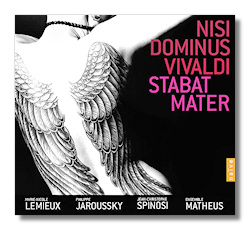
The Internet's Premier Classical Music Source
Related Links
- Vivaldi Reviews
- Latest Reviews
- More Reviews
-
By Composer
-
Collections
DVD & Blu-ray
Books
Concert Reviews
Articles/Interviews
Software
Audio
Search Amazon
Recommended Links
Site News
 CD Review
CD Review
Antonio Vivaldi

Sacred Choral Works
- Nisi Dominus, RV 608 1
- Stabat Mater, RV 621 2
- Credo, RV 592: Crucifixus 1,2
1 Philippe Jaroussky, countertenor
2 Marie-Nicole Lemieux, contralto
Ensemble Matheus/Jean-Christophe Spinosi
Naïve OP30453 DDD 41:59
This is not a generously timed CD, but it contains two of Vivaldi's most delectable sacred works for solo voice, and so it is both welcome and satisfying. Nisi Dominus, a setting of Psalm 126, has been recorded many times – by men (David Daniels, Andreas Scholl, James Bowman, etc.) and by women (Sara Mingardo, Teresa Berganza, etc.) Because it was composed in the early 1700s for the Ospedale della Pietà, Vivaldi probably intended the work to be sung by a woman, at least originally. It is hard to argue with singing as beautiful as Jaroussky's, however.
The text is not a long one, yet the Nisi Dominus is in nine movements, most of them setting just a line or two of Latin. The most outstanding of these is the fourth movement, an Andante, which begins by relating how the Lord gave his beloved people both sleep and children. The mention of sleep cues Vivaldi to write music of the greatest poise and delicacy, similar in mood to some of the slow movements in The Four Seasons, except more chromatic and suspenseful. At the words "Sicut erat in principio" (As it was in the beginning), Vivaldi calls on the old Baroque trick of returning to music heard at the very beginning of the work. Jaroussky's voice is one of the most beautiful ever to be attached to someone who calls himself a countertenor. It is neither masculine nor feminine. It's really an entity unto itself. Spinosi's lean and mean accompaniments keep the attention focused on Jaroussky.
The somewhat later Stabat Mater is another work that has been recorded by both men and women. Again, it probably was introduced by a woman, and because the text is a description of Christ's crucifixion through the viewpoint of the Virgin Mary, it makes sense to have a woman sing it. This is some of Vivaldi's most poignant music. Everything seems to disappear except the music itself. Still, it is not without drama. In the seventh section, for example, strings accompany the singer with repeated whip-like figures – probably a musical onomatopoeia for Christ's flagellation. Lemieux's rich and warm voice is well suited to this work, and her interpretation is emotional yet dignified.
The two works are aptly separated on this CD by the "Crucifixus" movement from Vivaldi's Credo. Actually, Vivaldi's authorship of this work is not certain, but its gentle vocal writing is so touching that it doesn't matter who composed it, as long as we are able to hear it!
Spinosi conducts and also plays the viola d'amore on this CD. The ensemble additionally contains six first and second violins, three violas, three cellos, contrabass, and continuo. This seems like a good size for this music, and the playing is energetic but not insensitive.
In the booklet note, Spinosi muses over what would have happened if the two singers exchanged works. I suspect the results would have been just as glorious!
Copyright © 2008, Ray Tuttle




















